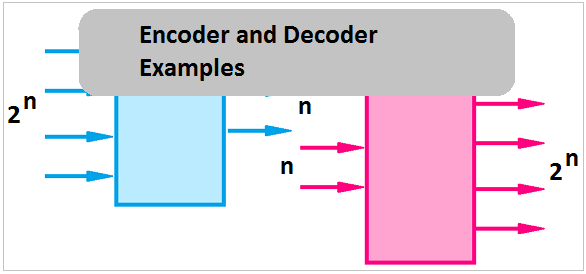Most Important Real Examples of Encoder and Decoder
Examples of Encoder are,
- Digital Keyboard Driver
- Touchpad Driver
- Biometric Converter
- Modem
- Digital Signal Processing Device or Circuit
- Analog to Digital Converter Circuit
- Transmitter Circuit in Optical Fiber Communication System
Examples of Decoder are,
- Led Driver
- Digital Display Driver Circuit or IC
- Modem
- Digital to Analog Converter Circuit
- Receiver in Optical Fiber Communication System
- Seven-Segment Display Driver
What is an Encoder?
The encoder is a device or circuit that encodes the signal or data or information from one form to another form. Basically, it decreases the number of bits from the input signal to the output signal by the formula, 2^n Inputs = n Outputs. In digital electronic circuits or other circuits, the encoder has a very important role. First of all, it reduces the number of bits without losing the actual information or data, so it is very helpful for low-cost transmission. Also, it is helpful for security because after encoding a piece of information it would not be visible in its original form. Basically, it is a binary converter circuit.
For example, in a transmitter circuit of an optical fiber communication system, you will see the use of an encoder. Basically, it encodes the large size of the binary-coded signal into a small size of the binary-coded signal and then it transmits through the transmission medium.
There are different types of encoders are available such as,
- 4 to 2 Encoder that takes four inputs and provides two outputs
- 8 to 3 Encoder that takes eight inputs and provides 3 outputs
What is Decoder?
A decoder is also a device or circuit that converts or changes the format signal just opposite to the encoder such as a small size of binary-coded signal into a large size of the binary-coded signal. Basically, a decoder converts the signal or data in the format of, n inputs = 2^n outputs. A decoder is a combinational logic circuit used in so many useful applications such as data multiplexing, instruction decoding, data demultiplexing, address decoding, etc. Generally, it is used after receiving the signal.
For example, you will see the use of a decoder in the receiver circuit of the optical fiber communication system. Here, the encoded information is decoded into the actual information or data. Also, you will see the seven-segment display used in calculators and other devices use decoder circuits or drivers.
There are different types of decoders are available based on the input and output lines, such as,
- 2 to 4 decoder that takes two inputs and provides four outputs
- 3 to 8 decoder that takes 3 inputs and provides 8 outputs
So, encoder and decoder are very useful devices they are not only helpful for data communication or transmission systems but they are also useful for driving different circuits and devices such as displays. Nowadays, in modern home automation systems, IoT(Internet of Things), encoders, and decoders play a very important role. The main difference between an encoder and a decoder is that an encoder converts information, like text or data, into a coded format for storage, transmission, or processing whereas a decoder takes the coded data and converts it back into its original form so it can be understood or used.
Read Also:

